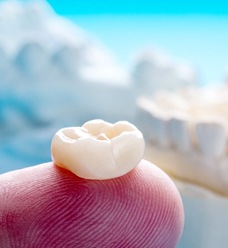Metal-Free Restorations – Ponte Vedra Beach, FL
Dazzling Solutions for Damaged Smiles
It’s extremely important to have your broken teeth repaired quickly so that you can continue using them to perform basic tasks like chewing and speaking that are necessary in your day-to-day life. You might be afraid that restoring your teeth means adding unsightly metal to your smile. Luckily, at Ponte Vedra Complete Dentistry, Dr. Townsend and Dr. Harth can offer realistic-looking metal-free restorations that make your repaired teeth look natural. Call us today to learn more about these beautiful options for bringing your grin back to full strength.
What are Metal-Free Restorations?

While traditional crowns and fillings can be made out of gold or a silver amalgam, we can instead use tooth-colored materials such as porcelain, ceramic, and composite resin. Said materials can closely mimic the way natural enamel reflects light, and they can be shaded to be the same color as the rest of your teeth. Yet despite not being made out of metal, these types of restorations are still highly durable and are more than strong enough to let you safely chew all manner of foods.
Benefits of Metal-Free Restorations

Aside from their obvious aesthetic appeal, metal-free restorations have numerous other benefits:
- Low Heat Conductivity: Since metal tends to conduct thermal energy, a metal restoration can leave a tooth extremely sensitive to hot foods and drinks. Porcelain and other tooth-colored materials, on the other hand, will not cause such problems.
- Hypoallergenic: Patients who suffer from severe metal allergies can have their smiles more safely repaired with tooth-colored materials.
- Stain Resistant: Porcelain in particular is well-suited for improving a tooth’s appearance because it doesn’t become discolored as easily as natural enamel.
- Longevity: As long as you continue to practice good oral hygiene and protect your mouth, your metal-free restorations can last about 10 years or longer.
Types of Metal-Free Restorations

Of course, there are a few different kinds of dental restorations to consider; the type you’ll get largely depends on the nature and extent of the damage. Below are just a few examples of restorations that can be created with tooth-colored materials.
Crowns
By placing a tooth-shaped “cap” on top of a broken tooth, we can hold the damaged structure together and prevent it from collapsing or cracking further. Sometimes crowns can also be placed for cosmetic reasons.
Fillings
Composite resin can be used to fill in cavities. Since the material can bond directly with the tooth, it normally requires fewer changes to the tooth’s overall structure. Furthermore, tooth-colored fillings don’t expand or contract when the temperature changes, meaning there’s no danger that they could accidentally damage your tooth after being exposed to a hot drink.
Dental Bridges
If a tooth is missing altogether, a dental bridge is an image-friendly way to fill the empty space. Each bridge consists of two crowns that hold prosthetic teeth between them; the crowns are attached to healthy teeth, but they’ll be shaded and shaped to blend in with your smile. Casual observers won’t even notice that a tooth has been replaced.
Inlays & Onlays
Inlays & onlays are like crowns except they’re only designed to cover part of the tooth instead of the whole thing. Typically, this means they require less prep work and will let you save more of your natural tooth structure.



